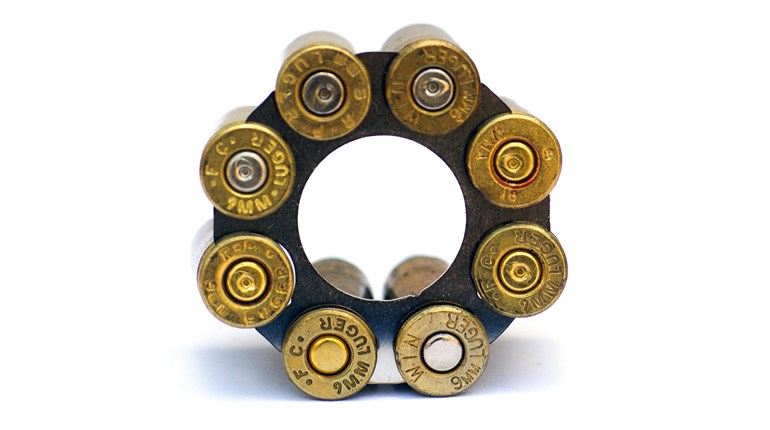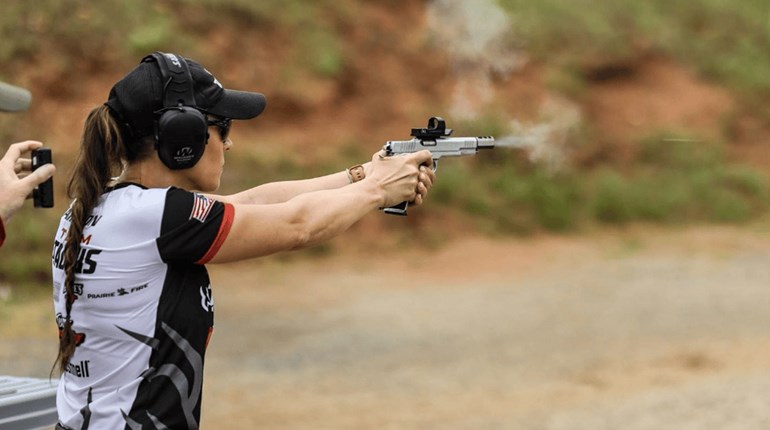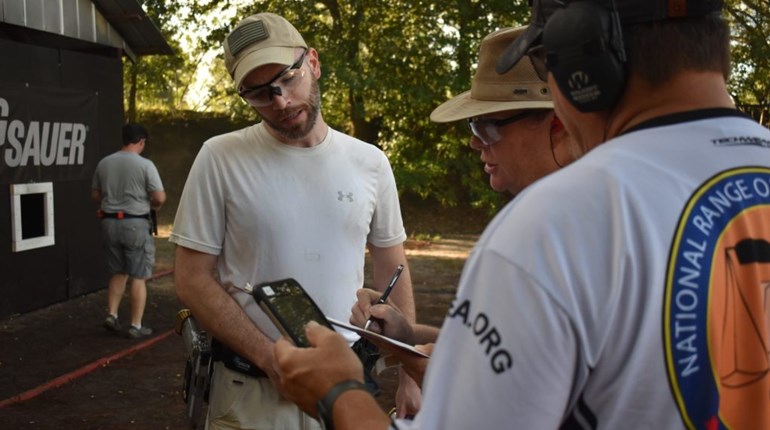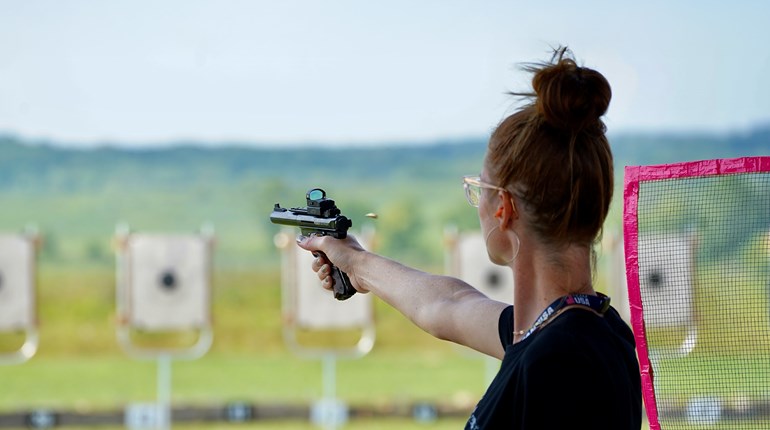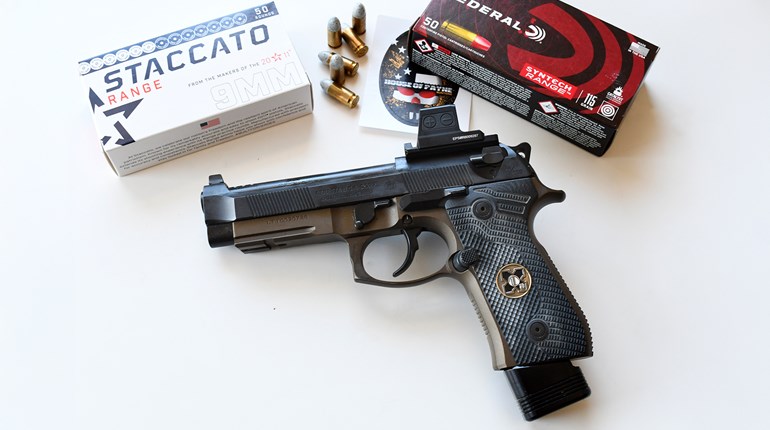
Picking up where we left off from my last article, here we complete the discussion of Outer Limits in Steel Challenge competition.
I encourage everyone to go back and refresh yourself with what was discussed in the last article before diving into this one, as you’ll want to ensure you understand that foundation before tackling this next part. The reason for this is as I mentioned last time, your footwork is what will determine your success or lack thereof on this stage. No matter how good you are at shooting longer distances accurately at speed, if you have poor footwork you will always struggle on this stage.
Shooters always used to comment to me after a run and hearing the Range Officer call out a sub-four-second time that it looking like I wasn’t moving very fast. That was not illusion. It was a result of superior footwork which anyone can master, regardless of your age.
With that as a background, we’ll now move into the remaining elements you need to master. The first of these is gun position. This one is quite simple: Do not lower the gun as you move—ever. Earlier, we talked about why people get the shooting order wrong. If you keep your gun up as you transition between boxes, after your first step out of the box the first target you should be seeing in your sights is the stop plate. This is how you know you are keeping you gun up and on target. Then, about the time your left foot comes down next to the left side of the center box, you should be seeing plate #4 in your sights. You should be refining your sight picture at this point so that the instant you are legally inside the center box you can break the next shot.
I used the term “legally inside the shooting box” for a specific reason. Once you have one foot inside the box and your other foot is no longer touching the ground, you are “inside the box” according to the rules, and can shoot without having to wait to plant your second foot firmly on the ground. Now I’ll warn you up front that this is an advanced technique, but it’s one of the ways in which top shooters manage to consistently shoot sub-four-second strings on this stage.
You probably don’t want to start out trying to learn to do this unless you are already a fairly accomplished shooter. You’re better off waiting until both feet are on the ground before breaking the shot, but this is something you definitely want to strive to learn how to do to some level. Definitely don’t try this for the first time during a match. Work at it during training, and once you’re comfortable and successful you can incorporate in a match setting.
Also note that the top shooters are not shooting with one foot in the air, but neither are they waiting to get both feet planted nice and steady before they begin shooting. With their right foot down and knee bent and their weight evenly distributed, they are breaking the shot as their left foot is making contact with the ground.
This technique, when executed correctly, is easily worth a savings of several tenths of a second. The other aspect of this technique is that you don’t want to stomp you left foot down entering the box, as all that will accomplish is bouncing your sight picture up and down, thus delaying when you can break the shot.
The reverse of this technique is also critically important to save time. When getting ready to exit the initial shooting box, just prior to or as top shooters are breaking the last shot, they start to lean in the direction they plan to move. This momentum shift helps reduce the total time spent moving. This is also one of the ways you help offset the fact that your shooting order in the left box is opposite the direction you plan to move.
One other big time-waster during the transition is that people love to look at the ground for some reason when they move. Spoiler alert: the Earth is not going anywhere, so there really is no reason to be looking at the ground. The real reason why people do this, of course, is because they haven’t worked out their steps ahead of time. They have no idea how big and/or how many steps they should take, so they look at the ground to try and figure it out in real-time so they don’t trip over their own feet. If you want to know if someone has been training on Outer Limits, simply watch their first run. If they look at their feet when moving, I can guarantee you they haven’t done any training.
To compound this error, they now need to lower the gun so they can see the ground, which means they have to waste more time trying to get it back up into position in time to take the next shot. This usually results in one of two things happening—they either rush the shot because they realize they are losing time and miss the plate, requiring a make-up shot which wastes even more time, or they just end up taking a long time to break the shot because they have to reacquire the target and reacquire a good sight picture. Neither of these are on the path to Steel Challenge shooting greatness.
One cautionary note here—when you are first starting out, I would advise against trying to do some of the more advanced techniques described above. Just getting the shooting order correct and figuring out ahead of time your transition steps will both put you far ahead of your competition and produce lower times. Once your basic footwork has become subconscious via training, then go ahead and start incorporating some of the more advanced footwork concepts described here.
You likely noticed by now that nowhere during this discussion have I talked about the fact that you need to be able to run fast to shoot Outer Limits well. That’s because you don’t. When a shooting buddy of mine who happened to be a smallbore rifle national champion saw me shoot Outer Limits for the first time in a match with a resulting string time of 3.86 seconds, he asked me, “How are you doing that? You’re not even moving very fast.” Exactly …
The key is not foot speed but shooting efficiency. It’s the same technique that top USPSA shooters use to get those stage times which are consistently three to five seconds faster than their competitors. They don’t really run faster than their competitors nor do they really shoot faster. What they do is everything in between shooting more efficiently, thereby spending the absolute minimum amount of time between actually shooting targets. Remember, every tenth of a second you spend not pulling the trigger is wasted time when you’re not scoring, so you need to minimize or eliminate as much of this as possible.
In and of themselves, each little technique I described above won’t make that much difference in your overall run time. However, when you can execute all of them correctly, the cumulative effect can be a drastic decrease in your times. There is a lot going on when shooting this stage, more so than any other stage in Steel Challenge. But because most people shoot this stage poorly, this can be the difference between winning and losing a match, even if you are on par for every other stage or even slightly behind your nearest competitor.
Put in the extra effort to get the details right on this stage and it can put you miles ahead of your competition. It may also be just the difference you need to go from a perpetual second or third place shooter, to the match champion. And of course, as always, remember—slowing down is never the right answer, never—you need to learn to see faster.
Article from the March/April 2025 issue of USPSA’s magazine.














